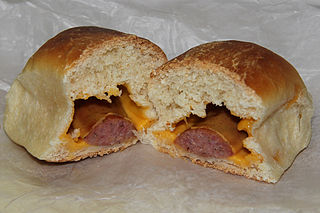
Hungarian or Magyar cuisine is the cuisine characteristic of the nation of Hungary, and its primary ethnic group, the Magyars. Hungarian cuisine has been described as being the spiciest cuisine in Europe This can largely be attributed to the use of their piquant native spice, Hungarian paprika, in many of their dishes. A mild version of the spice, Hungarian sweet paprika, is commonly used as an alternative. Traditional Hungarian dishes are primarily based on meats, seasonal vegetables, fruits, bread, and dairy products.

A sausage roll is a savoury dish, popular in current and former Commonwealth nations, consisting of sausage meat wrapped in puff pastry. Although variations are known throughout Europe and in other regions, the sausage roll is most closely associated with British cuisine.

Austrian cuisine is a style of cuisine native to Austria and composed of influences from Central Europe and throughout the former Austro-Hungarian Empire. Austrian cuisine is most often associated with Viennese cuisine, but there are significant regional variations.

Ukrainian cuisine is the collection of the various cooking traditions of the people of Ukraine, one of the largest and most populous European countries. It is heavily influenced by the rich dark soil (chornozem) from which its ingredients come, and often involves many components. Traditional Ukrainian dishes often experience a complex heating process – "at first they are fried or boiled, and then stewed or baked. This is the most distinctive feature of Ukrainian cuisine".

Bulgarian cuisine is part of the cuisine of Southeast Europe, sharing characteristics with other Balkan cuisines. Bulgarian cooking traditions are diverse because of geographical factors such as climatic conditions suitable for a variety of vegetables, herbs, and fruit. Aside from the variety of local Bulgarian dishes, Bulgarian cuisine shares a number of dishes with its neighboring countries, in particular with Turkish and Greek cuisine.

A hush puppy is a small, savory, deep-fried round ball made from cornmeal-based batter. Hushpuppies are frequently served as a side dish with seafood and other deep-fried foods.
Serbian cuisine is a Balkan cuisine that consists of the culinary methods and traditions of Serbia. Its roots lie in Serbian history, including centuries of cultural contact and influence with the Greeks and the Byzantine Empire, the Ottomans, and Serbia's Balkan neighbours, especially during the existence of Yugoslavia. Historically, Serbian food develops from pastoral customs that involved the keeping of sheep in mountain highlands, in a climate and regional context that favoured animal husbandry over vegetable farming; Serbian food is therefore traditionally richer in animal products and basic grains—corn, wheat and oats—than fresh vegetable dishes. Following the abandonment of widely practiced pastoral lifestyles, Serbian food emerged through the Middle Ages heavily dependent not on lamb or mutton, but on the keeping of pigs for the annual cull and the production of various cured meats, such as sausages, bacon and ham products.

Czech cuisine has both influenced and been influenced by the cuisines of surrounding countries and nations. Many of the cakes and pastries that are popular in Central Europe originated within the Czech lands. Contemporary Czech cuisine is more meat-based than in previous periods; the current abundance of farmable meat has enriched its presence in regional cuisine. Traditionally, meat has been reserved for once-weekly consumption, typically on weekends.

A klobasnek is a chiefly American Czech savory finger food. Klobasneks are much more commonly known as kolaches in Texas, but should not be confused with traditional Czech kolaches, which are also popular and are known by the same name. Klobasneks are similar in style to sausage rolls, but the meat is wrapped in kolache dough. Klobasneks have become a significant element of Texan culture and can be found everywhere from gas stations to specialized kolache shops throughout the state, even outside areas with large Czech Texan populations.
The cuisine of Kosovo is a representative of the cuisine of the Balkans and consists of traditional dishes by ethnic groups native to Kosovo. Due to ethnic connections with Albania, it has been significantly influenced by Albanian cuisine and has adopted elements of other Balkan countries.

Regional street food is street food that has commonalities within a region or culture.

Swabian cuisine is native to Swabia, a region in southwestern Germany comprising great parts of Württemberg and the Bavarian part of Swabia. Swabian cuisine has a reputation for being rustic, but rich and hearty. Fresh egg pastas, soups, and sausages are among Swabia's best-known types of dishes, and Swabian cuisine tends to require broths or sauces; dishes are rarely "dry".

Pigs in blankets, kilted sausages or kilted soldiers is a dish served in the United Kingdom and Ireland consisting of small sausages wrapped in bacon. They are a popular and traditional accompaniment to roast turkey in a Christmas dinner and are served as a side dish.

Bacon-wrapped foods are foods that are prepared by being covered in bacon. They may be baked, fried, or grilled. Popular bacon-wrapped dishes include angels on horseback, devils on horseback, and pigs in blankets. Bacon has long been used for barding roasts, especially game birds.

Malawach or Melawwaḥ or מלאוואח,, is a flatbread that is traditional in the Yemeni cuisine. It was brought to Israel by Yemenite Jews. Malawach resembles a thick pancake but consists of thin layers of puff pastry brushed with oil or fat and cooked flat in a frying pan. It is traditionally served with hard-boiled eggs, zhug, and a crushed or grated tomato dip. Sometimes it is served with honey.















